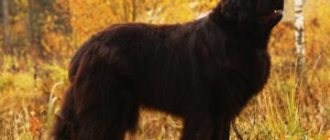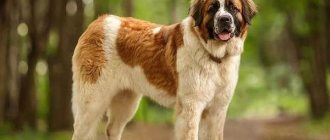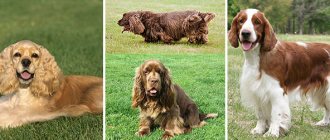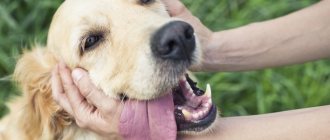There are quite a lot of monuments to dogs in the world; people love these four-legged pets during their lifetime and do not forget them after death. Perhaps the most famous monument to this animal is in Paris: the monument was opened almost two hundred years ago in honor of the famous dog, St. Bernard Barry. On the pedestal you can see a mighty dog and a child clinging to him in search of salvation.
Saint Bernards are the first dogs that were bred to perform rescue functions. They have been saving people for centuries, so the Barry monument is essentially a sign of gratitude to all animals of this breed.
Despite the development of technology, dogs are still indispensable assistants to rescue services today.
From the history of rescue dogs
In the Alps there is the Great Saint Bernard Pass. It is famous for its harsh weather conditions: in winter frosts reach -30 ° C, and bad weather rages here most of the year. Since the border between Switzerland and Italy passes right there, in ancient times there were brave souls who risked going through the pass using the shortest route. But many lost their way, fell into snowstorms and often died in an avalanche.
In the 11th century, the Saint Bernard Shelter was built on the pass. Here travelers could rest, refresh themselves and warm up before continuing on their way. But not everyone was able to reach this saving island.
The monastery of Saint Bernard still stands in its place, only having changed in appearance
In the 17th century, monks began to actively use dogs of the Alpine Mastiff breed to detect freezing, in trouble or lost travelers (after the name of the pass they later became known as St. Bernards). They were distinguished by their ability to anticipate bad weather and had an excellent sense of smell, thanks to which they could detect a person even under a snow pile. The dog’s task was to search for the victim, dig him out from under the snow and warm his face with his warm breath and tongue. These dogs did not have any kegs, much less alcohol.
Alcohol will not help a freezing person, but will only harm. Under its influence, blood vessels dilate and heat transfer increases, which, on the contrary, will accelerate freezing and hasten death for a person in trouble and immobilized.
Saint Bernards are still trained to search and rescue people in the mountains to this day.
Video: St. Bernard - a rescue breed
Kinds
Dangerous work and low prevalence led to the fact that at the beginning of the 19th century the number of St. Bernards decreased to a critical level. To restore numbers, two Newfoundland males were brought to the monastery.
As a result of interspecific crossing, a new variety of St. Bernards appeared: long-haired. The hope that a reinforced coat would improve the working qualities of dogs was not justified. The resulting long-haired variety turned out to be of little use for rescue activities.
The line founded by the Newfoundlands was not stopped. On the contrary, the long-haired version of the dog was favorably received by the public and began to spread quickly. This was facilitated by the intelligence, nobility, goodwill and formidable appearance of the four-legged friend. Today two lines are developing in parallel: short-haired and long-haired.
In the middle of the 20th century, several attempts were made to develop new breeds. The result of crossing the St. Bernard with other large dogs was the appearance of the Moscow Watchdog. It is sometimes called the Moscow St. Bernard .
Until the 80s of the 20th century, there was a periodic influx of St. Bernard blood into this breed. Now the purity of the breed line is maintained. The main task set by the breeders was to enhance the guarding qualities of the dog. They achieved this. It is not for nothing that the name of the breed contains the word “guard”.
Shorthaired Saint Bernard
The most famous rescuer is Barry the dog
The most famous rescuer was an Alpine mastiff named Barry. The monks testified that he went in search of victims on his own, without waiting for a command from people, but simply anticipating the approach of a snowstorm or an avalanche. If he could not cope with the rescue on his own, Barry would return and bark for the monks to go after him. He has saved 40 lives.
Barry's effigy is on display at the Bern Museum
On the monument to Barry, erected in Paris opposite the entrance to the dog cemetery, it is written that he saved 40 people, and the 41st killed him. Allegedly, an unconscious Swiss soldier mistook Barry for a wolf and stabbed him with a bayonet. But there is evidence that the aged Barry lived out his life quietly with a monk in Bern and died at the age of 14.
After Barry's death, his body was buried, but the skin was removed, and with its help a stuffed dog was made, located in a museum in Bern. In 1923, during the reconstruction of the stuffed animal, a barrel was hung around the dog's neck to popularize the myth of rescue dogs created by the famous painter Edwin Landseer.
Price
Saint Bernards are considered a rare breed. It's not easy to maintain them. Therefore, the price for purebred puppies is high. But even offspring from titled producers may have some defects.
If the existing defect does not interfere with life, but is a serious deviation from the breed standard (for example, an incorrect bite), then the price of a St. Bernard can range from $100 to $500. This is the so-called Pet class.
Many puppies do not deviate from the breed standard. But the experienced eye of an expert sees some imperfections. Such a puppy can cost $500-$1000. This is Breed class. Perfect puppies from all points of view, future champions and future parents of champions are valued at an amount exceeding $1000. This is Show class.
Where did the myth of the keg come from?
The idea of a barrel on a St. Bernard's neck came to the mind of the English artist Edwin Landseer, who often depicted dogs in his paintings.
A breed of dog was named after Sir Landseer - the spotted variety of Newfoundland - which he especially loved to portray.
In the painting “Alpine Mastiffs Revive a Lost Traveler,” the barrel first appears before the eyes of the audience. It was added “for piquancy,” for greater artistic expressiveness.
A keg of alcohol appears for the first time in Landseer's painting around the rescue dog's neck.
In fact, St. Bernard rescuers are necessarily provided with special first aid packages for victims. A dog can be the first to reach a person under the rubble and provide him with... not a sip of alcohol at all, but food and water to maintain strength, a blanket for warmth, and a first aid kit.
A rescue St. Bernard's bag contains only what will help a person maintain strength until people arrive, but alcohol is not included in this list
A barrel of alcohol around a St. Bernard's neck is a myth. Rescue dogs never wore them at all. This attribute is used only for photo sessions, emphasizing the importance of the mission of these animals.
- Author: Natalya Mikhailyuk
Rate this article:
(17 votes, average: 4.1 out of 5)
Saint Bernards became popular largely thanks to the family comedy “Beethoven” of the 90s, which was liked by millions of people around the world. But the history of this breed in itself is interesting and original.
It all started with the fact that in 962 Bernard of Menton founded a monastery and shelter for travelers in the Swiss Alps at an altitude of about 2500 m. The place was not chosen by chance; there was a mountain path along which pilgrims often walked, heading from France to Italy. The path was considered difficult and dangerous, because the traveler could always get caught in an avalanche, a snowstorm, or be attacked by villainous robbers. Bernard's idea was that the wounded and cold traveler could warm up, rest and heal in his shelter.
In 1681, Bernard of Menton was canonized, and the monks of his monastery began to breed dogs that would help them save travelers in trouble. Over the course of many years, the monks managed to breed a mastiff that was able to easily endure harsh weather conditions, was quite strong, but at the same time very friendly and loyal. A keen sense of smell and hearing made it possible to find people, even in a snowstorm and under the snow. Initially, the breed began to be called “Barry”, this nickname was given to one of the mountain rescue dogs. Barry (from the German Bären, “bear”) saved the lives of 40 people in the snow. Later they began to use the name "Saint-Bernard", that is, Saint Bernard, it was mentioned unofficially in 1833, and in 1880 it became official. Over the years, these friends of man are credited with saving more than 2,000 lives.
Photo www.lapkins.ru
With the advent of helicopters in 1950, the help of St. Bernards in rescuing those who were freezing began to rapidly lose relevance. The number of monks in the monastery also began to decrease, until there were only 4 of them left. Keeping such dogs is very expensive and labor-intensive, so the remaining monks decided to put the last pets up for sale in 2004, reasoning that it would be better for everyone, since there was work for the furry rescuers no more in the mountains. Nevertheless, this step caused widespread public outcry. Various entrepreneurs, whose business relied on thousands of tourists who come every year to visit the monastery and look at the famous dogs, were very indignant. The issue was resolved quickly; a couple of Swiss philanthropists were found who donated about $4,000,000 to ensure that the St. Bernards remained in the monastery, and breeding and caring for them continued. For these purposes, a non-profit organization, the Barry Foundation, was established. For the winter, the dogs are sent to a kennel in the Swiss city of Martigny, and in the summer they return to the monastery to the monks. In honor of the dogs, a museum was opened in Martigny in 2006.
Photo www.dskkapital.ru
PS Interesting detail. Saint Bernards are often depicted with a small barrel hanging from their neck. This accessory first appeared in a painting by Edwin Landseer, when he was only 17 years old. It was believed that the barrel contained brandy, which the dog treated to the frozen traveler. The concept quickly gained a lot of popularity in the community, but the dogs did not actually carry any kegs of booze. And it would be strange if you then tried to drag this drunken man to the monastery, otherwise he might even get there on his own, just show him the way. Not to mention, alcohol contributes to dehydration. But on the other hand, when the helicopter is already on its way, why not cash in on 150 with your faithful furry friend?
Subscribe and like! :)
A store where you can find everything at the best prices!
In Russia, St. Bernards are affectionately called “Senechka.” And the homeland of these giants is the Great St. Bernard Pass, which is located in the Alps. Many people prefer this breed of large dogs, which are the best rescuers because they can overcome very difficult to reach places. They are also considered a person’s great friends, as they are always ready to help him.
Maintenance and care
It is best to keep a St. Bernard in a spacious private house with a plot. Such a giant will feel cramped in a small city apartment. Long-haired representatives of the breed live without problems in an outdoor enclosure; individuals with short hair are best kept indoors in winter. You cannot put a St. Bernard on a chain.
Saint Bernards are quite slow. But an adult dog needs to walk 3-4 hours a day. In summer, it is better to reduce walks; it is advisable for the pet to be in the shade. Due to their thick undercoat, these dogs cannot tolerate heat.
Caring for a St. Bernard is simple; normal hygiene procedures are required: rubbing eyes, ears, brushing teeth and trimming nails. Only because of the peculiarities of the structure of the muzzle is it necessary to wash it after eating.
It is advisable to comb long-haired animals every other day, and daily during shedding. You will need a comb with long, sparse teeth. For short-haired dogs, it is enough to brush them once a week. To do this, you can use a stiff brush or rubber mitt. It is better to trim the hair between the fingers and in the ears.
It is not recommended to bathe these dogs often - 2-3 times a year is enough. It is advisable to do this after shedding to facilitate hair change. After walks, you need to wash your paws; your pet should be taught this procedure from an early age.
The pictures show how to keep a St. Bernard:
Health
The health of representatives of this breed is not very good. Even with proper maintenance, St. Bernards do not live longer than 11 years. These dogs are prone to obesity and allergic diseases. But most often they have joint pathologies. They have dysplasia and dislocations. Eye diseases can also develop due to drooping eyelids.
Nutrition
Saint Bernards are prone to obesity, so you need to choose your diet carefully. It is recommended that you consult your veterinarian about how much food this dog needs. The easiest way to determine the amount of dry food is about 1 kg per day. Any premium or super-premium food for large breeds will be suitable.
When feeding naturally, the bulk of the diet should be lean meat. His adult dog requires at least 500 g per day. The rest is cereals, vegetables, fermented milk products. You can give cottage cheese, eggs, offal, sea fish. Sweets, legumes, fatty and fried foods, marinades, confectionery and baked goods are prohibited. Additionally, it is recommended to give vitamins, calcium and collagen are especially important.
Saint Bernard Pass
There was a narrow rocky path through the St. Bernard Pass. It connected Italy with Western Europe.
In bad weather, when there were snowstorms and drifts, such a road became especially dangerous. In this place there was a monastery, which became a mountain shelter for travelers. It was founded by Bishop Bernard of Menton. This happened back in 1049. Then the pass and the monastery were named after the Bishop of Saint Bernard - Saint Bernard.
Training
Training begins with simple walks. Teaching a dog not to play with a leash, not to take food from strangers, not to allow strangers to stroke and caress him is a big victory at the initial stage of training.
Many experts believe that results can only be achieved by affection and redirecting the puppy’s attention. Others are of the opinion that punishment is a natural and acceptable way to internalize prohibitions.
The most important of the prohibiting commands is “fu”. But with any method of bringing the prohibition to the dog’s mind, this command should not be given often. Otherwise it loses its significance. At the age of several months, even an inexperienced trainer is able to teach a dog to follow simple orders: “sit”, “come to me”, “voice” and the like.
Saint Bernards react quickly to other dogs, but never show aggression
Further training usually begins at about one year of age. The dog does not yet lose sensitivity to training and acquires a stable psyche. The dog usually acquires special skills under the guidance of an experienced trainer at the age of 1 to 2 years.
Dogs at the monastery
In difficult weather conditions, many people died, unable to reach the monastery. Then the monks got four-legged helpers - St. Bernards. These dogs were used to search for and rescue lost travelers. The animals were strong and resilient. They were distinguished by their great love for people. We felt a person in a snowdrift at a depth of up to six meters.
The dogs could navigate the mountains well and quickly found their way home. Anticipating an imminent change in the weather, they began to fuss, get nervous and hurried to go to the mountains on their own in order to come to the aid of the person in time.
About three or four dogs took part in searching for people in trouble. When the dogs found the victim, two of them lay down next to him, warming up the person, licked his face and shook him as best they could. And the rest ran to people for help.
Dog lovers consider the pass to be the birthplace of St. Bernards. And here, in the currently operating monastery, there is a famous nursery for breeding this breed.
And in a local hotel you can see a painting of a dog very similar to a St. Bernard.
Breed traits
Breed traits (on a 5-point scale)
| Saint Bernard | |||
| Activity | in the house | 1.9 | |
| on the street | 3.1 | ||
| Obedience | training | 3.9 | |
| strangers | 4.2 | ||
| Domination | in family | 1.6 | |
| over dogs | 2.1 | ||
| Defending your territory | from people | 2.5 | |
| from dogs | 2.9 | ||
| Sociability | in family | 4.8 | |
| with strangers | 4.1 | ||
| with dogs | 3.3 | ||
| Concentration | in family | 1 | |
| in front of strangers | 1.5 | ||
| with dogs | 2.3 | ||
| Aggressiveness | in family | 1 | |
| to strangers | 1.4 | ||
| to the dogs | 1.7 | ||
| to cats | 1.5 | ||
| Family behavior | calmness | 4.1 | |
| demand for affection | 4.4 | ||
| excitability | 3 | ||
| playfulness | 3.5 | ||
| excessive barking | 1.7 | ||
| behavioral breakdowns | 1.9 | ||
| Tolerance for children | up to 4 years | 4.3 | |
| over 4 years old | 4.4 | ||
| Institutional use | watchman | 3.4 | |
| bodyguard | 1.7 | ||
This breed is often compared to the following dog breeds: Newfoundland, Caucasian Shepherd, German Shepherd, Labrador Retriever, Leonberger.
The photo shows what St. Bernards look like:
What did the dog look like?
In those distant times, the dogs described were significantly different in appearance from modern St. Bernards. They were more mobile and less massive.
The advantage of this dog is its thick skin. It perfectly protects from cold and snow. Very thick, this short coat did not get wet, did not become covered with icicles, and perfectly protected against hypothermia.
A dog's resistance to bad weather is actually limitless - it can stay in deep snow for a day, even in the most severe storm, without the slightest harm to health.
The animal has a very high reaction speed and an exceptionally keen sense of smell. This is what allows her to quickly find people under the snow.
Learning ability
Saint Bernards are very smart, and most importantly, their heredity presupposes an intuitive understanding of humans. They are quite disciplined by nature and quickly learn the basic rules of behavior. But you need to start training your dog as early as possible. An adult St. Bernard may simply get bored with monotonous training and become stubborn. Therefore, we will give this dog’s learning ability 3 points on a five-point scale.
Monument to Saint Bernard Barry in Paris
It was installed about 180 years ago in a Paris cemetery. A bronze statue of a huge dog and a child clinging to it. On the pedestal there is an inscription: “Barry, who saved forty people and was killed forty first.” This is a monument to all St. Bernards who save people.
Among the dogs of this breed there were their champions. One of the famous rescuers was a St. Bernard named Leo. He has 35 saved souls to his credit. But St. Bernard Barry became more famous. It was he who saved forty people, and he himself died at the hands of the forty-first. There is a legend about how this all happened.
Attitude towards children
The St. Bernard is exactly the kind of huge, kind dog that will become an ideal family pet. In the family circle, this is a good-natured teddy bear who will endure the pranks of children with endless patience and will enthusiastically and carefully play with older children. This is a real nanny dog, guardian, friend and protector of children. In terms of his relationship with kids, the dog deserves a solid A.
Just keep in mind that if you have a baby in your family and you also get a St. Bernard, the puppy will very quickly outstrip the human baby in both height and weight.
St. Bernard - photo of a giant, loyal, shaggy friend
How Barry died
One day there was a strong storm. The dogs, as usual, went out to search for the injured people. Gradually they returned to the monastery. Everyone was very tired and exhausted. Only St. Bernard Barry continued to search for those in trouble. He wandered and wandered among the mountains. Obviously, the dog felt that there was a person lying somewhere under the snow.
The dog's instincts were right. He found a traveler covered in snow. The dog began to free him from captivity. He shook and licked the poor fellow's face. But the man, waking up, opened his eyes and saw a large dog's face. Frightened, he decided that there was a wolf in front of him. A man killed St. Bernard Barry with a pistol.
According to another legend, a dog was stabbed to death with a knife. This was done by the forty-first person he saved.
Since then, a dog named Barry has always lived in the monastery kennel. It is named after him.
Health
Saint Bernard is not one of the most painful dogs. After all, his distant ancestors were adapted to survive in the harshest conditions. However, this does not mean that they do not get sick. Their weakest point is the musculoskeletal system. Considerable weight does not have the best effect on joints.
Dysplasia, dislocations and osteosarcoma are some of the most common reasons for contacting veterinarians among owners of this breed.
In addition, these animals are predisposed to such ophthalmological problems as entropion, cataracts and third eyelid adenoma, also called “cherry eye”.
Alas and ah, even in the most excellent home conditions with sufficient physical activity and a balanced diet, St. Bernards live very little - rarely do any of the giants live to be 10 years old, and this is perhaps the main drawback of the breed, according to the reviews of the owners themselves, who were forced to part with your favorites.
pixabay.com/Alexas_Fotos
The legend of saving a child
Another legend says that St. Bernard Barry is a hero dog. According to her, the dog actually saved forty-one people. The forty-first person saved was a child. No one knew how he got to the pass and found himself completely alone in a dangerous situation.
When St. Bernard Barry sensed him, the child was alive but unconscious. The dog helped in time: he lay next to the boy for a long time, warming him with his body, and licked his face. When the child woke up, he had no strength at all. All he could do was wrap his small arms around the dog's neck.
Barry tried to carry the baby very carefully. The dog was old and had a very hard time. The kid saw this and tried to ride the dog. This is how they came to people.
Barry lived out his life in the city and died of his own death, having served the people for about twelve years.
The story of St. Bernard Barry is true, and there is much evidence of it. The stuffed dog still stands in the Natural History Museum in the Swiss city of Bern.
Upbringing
Due to their docile nature, St. Bernards are quite easy to train, and problems with them rarely arise even among inexperienced dog breeders. It is necessary to begin the educational process literally from the first day the puppy is in your home. Immediately let your child know who is in charge here and explain the basic rules of behavior on your territory.
The most important thing that a new resident must learn is: it’s impossible - it’s always impossible. And today, and tomorrow, and the day after tomorrow. Don’t take a cute lout to bed if you don’t want to find next to you a shaggy and slobbering carcass weighing a hundredweight in a year. Don't serve goodies from your table unless you plan to constantly dine in the company of a dog who rests his muzzle on his knees, even if those knees are wearing expensive trousers. Forbid jumping on yourself when meeting, because over time these violent manifestations of feelings can turn into trauma for you.
Important! Don't expect an immediate reaction from your pet. Melancholy Saint Bernards usually need time to “wind up.” Be patient and persistent, and the dog will definitely understand what you want from him.
Never shout or hit a dog - this will only cause you to lose its trust and raise a downtrodden neurasthenic instead of a proud giant.
pixabay.com / ClaudiaWollesen / 120 images
Characteristics of a rescue dog
The breed of the pet must correspond to the goals and conditions of the search and rescue operation. For example, dogs that are able to withstand low temperatures and have sufficient physical strength to not only indicate the location of a person, but also dig him out and pull him out from under the snow, are most effective in helping to rescue climbers.
However, good physical data is not all that is required from a four-legged rescuer. If he is psychologically unable to work in extreme conditions, then his use in rescue operations is inappropriate.
During the training process, the dog is taught many important skills that help perform the surgery effectively. During training, her psychological and physical capabilities are also assessed. According to experts, a rescue dog must have the following qualities:
- excellent physical shape, strong physique;
- well-developed sense organs: vision, smell, hearing;
- endurance;
- equilibrium;
- courage;
- stress resistance;
- good learning ability;
- high intellectual abilities: the ability to quickly and accurately respond to human commands, as well as act independently (in emergency cases);
- the ability to communicate with strangers and other animals and to react calmly to them.
To become a rescuer, an animal undergoes serious training. Based on the results of the training, specialists decide on the possibility of his participation in search operations.
Feeding ration
To ensure good health for your St. Bernard, you need to have the right diet. Due to its large weight, the dog requires a balanced diet, with additional supplements. At the same time, the number of calories is observed so as not to lead the pet to obesity and health problems. In this situation, specialized dry food can be a real salvation for the owners, but many still continue to lean toward natural nutrition, and then they will have to pay a lot of attention to the food.
Feeding the St. Bernard:
- Lean meats containing bones and cartilage;
- By-products, such as tripe (boiled only);
- For porridges, it is recommended to give rice and buckwheat. In winter, add wheat. Porridge is served separately, without any admixture;
- Vegetables and fruits are required; they can be either raw or cooked;
- The puppies are given jellied meat cooked on chicken feet, but before serving they are taken out, leaving only the broth.
- Natural fermented milk products;
- Sea (raw), river (boiled) fish.
Protein makes up a third of a dog’s diet, fiber only 5%.
Mountain rescuers
Mountains are considered one of the most difficult places to work. Low temperatures, strong winds, as well as sudden changes in weather conditions require unprecedented endurance from animals and humans. To work in the mountains, strong, large animals are used to be able to get a person out of the rubble or bring equipment. Their coat should be thick, with a dense undercoat, which protects them from low temperatures.
Saint Bernard
These dogs have been rescuing climbers in the mountains for several centuries. Initially, they were used for protection by the servants of the monastery of St. Bernard in the Swiss Alps (XVII century), hence the name of the breed (Saint-Bernard).
Over time, climatic conditions in the Alps began to change and cases of snow melting became more frequent. Saint Bernards began to be used not only as guards, but also as escorts when crossing the mountains. They have a flexible disposition and endurance, so they were often used as pack animals for transporting goods. Their ability to predict avalanches often saved the lives of travelers.
Saint Bernards are very affectionate, calm and friendly. They treat small children with care and patience, are not afraid of strangers and react calmly to other animals. They are not aggressive and will not bark without a reason. However, if threatened, their instincts will react quickly.
Saint Bernards are intelligent and trainable. They have an excellent sense of smell, capable of sensing a person at great depths under the snow. They are able to dig out the victim and signal his location to the rest of the rescue team.
Dogs of this breed are large and powerful. Their average height is 80 cm, and their weight is more than 70 kg. They have thick, long or short (depending on the breed type) coat with undercoat. This coat allows them to withstand cold temperatures and can help warm injured climbers.
German Shepherd
The German Shepherd is one of the most popular working dogs. It is used in various spheres of human life (security, police, military service, etc.). These dogs also help climbers and other victims of various disasters.
German Shepherds are versatile. They cope well with search operations, both in the mountains (in cases of snowfalls) and in the lowlands after earthquakes and other disasters, looking for people under the rubble.
German Shepherds are suitable in all respects for working in special operations in the mountains:
- they are smart and easy to train;
- balanced, psychologically stable;
- quickly adapt to unfamiliar surroundings and navigate the terrain;
- withstand cold weather;
- have good health.
The average height of a shepherd dog is 50-60 cm, and weight is 50 kg. She has an excellent sense of smell, vision and hearing, which allows her to find the victim at great depths. At the same time, trained shepherd dogs are able not to be distracted by extraneous smells and noises, concentrating on searching work.
German Shepherds have a powerful muscular corset and strong paws. This helps them dig a person out of the rubble. And well-developed sense organs make it possible to guide the victim to a safe place (shepherd dogs are also often used as guides for blind people).
Bernese Mountain Dog
The breed was originally bred in Switzerland. The Mountain Dog's tasks included herding livestock, performing guard functions and being a faithful companion for humans. This breed perfectly performs these tasks to this day.
The Bernese Mountain Dog is a large and strong dog. Her average height is 60-70 cm, and her weight is about 50 kg. She has long and thick hair, which allows her to withstand frost well.
The breed is distinguished by a high degree of socialization, friendly disposition, calm character and obedience. Therefore, pets are often used to search for people during disasters. They know how to clearly follow commands and interact with a stranger. They can quickly track down a victim in the rubble, attracting the attention of the search party to the desired location with loud barks.
Alaskan Malamute
These are energetic and strong dogs, characterized by strength and endurance, independence and intelligence. Their average height is 60 cm, and their weight is no more than 40 kg. Outwardly, they look like a wolf, but they are absolutely domestic pets with a delicate mental organization that cannot tolerate loneliness. Initially, the breed was created to help people living in northern latitudes:
- for transporting goods over long distances;
- for hunting seals, polar bears, etc.;
- for protection from wild animals and intruders.
Nowadays, the Alaskan Malamute is often used for search and rescue operations. It has important characteristics that are necessary for working in extreme conditions:
- endurance, the ability to work long hours;
- strength (dogs are able to easily transport heavy loads in a sled, including a wounded victim);
- an innate love of digging deep holes;
- intelligence (Alaskan Malamute can make decisions independently, without human command).
A stubborn disposition and excessive independence often cause difficulties in raising a pet. Therefore, his training is carried out by experienced specialists. With proper training, the Alaskan Malamute will become an excellent rescue dog and reliable companion.
Character
Peaceful and obedient dogs are unlikely to show their grin to others just like that. The only reason for aggression can be a threat to the life of the owner and other family members. Pets behave aloofly with other dogs, if we talk about animals with whom they do not share shelter. The character of the St. Bernard can be called firm, strong-willed. Reasonable, calm and sensitive creatures show excessive playfulness only in puppyhood.
According to the description of the breed, they never neglect the opportunity to entertain children. Saint Bernards and children are two complementary concepts. Yes, yes, huge shaggy dogs are wonderful nannies. Animals with a patient character protect children from falls, allow themselves to be patted by the ears and even the tail, and in winter they can serve as sled dogs for kinders. These are the main characteristics of good-natured dogs. What will your pet be like? Depends on innate character traits and, of course, upbringing.











